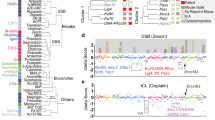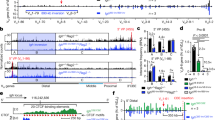Abstract
Immunoglobulin H class-switch recombination (CSR) occurs between switch regions and requires transcription and activation-induced cytidine deaminase (AID). Transcription through mammalian switch regions, because of their GC-rich composition, generates stable R-loops, which provide single-stranded DNA substrates for AID. However, we show here that the Xenopus laevis switch region Sμ, which is rich in AT and not prone to form R-loops, can functionally replace a mouse switch region to mediate CSR in vivo. X. laevis Sμ–mediated CSR occurred mostly in a region of AGCT repeats targeted by the AID–replication protein A complex when transcribed in vitro. We propose that AGCT is a primordial CSR motif that targets AID through a non-R-loop mechanism involving an AID–replication protein A complex.
This is a preview of subscription content, access via your institution
Access options
Subscribe to this journal
Receive 12 print issues and online access
$209.00 per year
only $17.42 per issue
Buy this article
- Purchase on Springer Link
- Instant access to full article PDF
Prices may be subject to local taxes which are calculated during checkout







Similar content being viewed by others
References
Jung, D. & Alt, F.W. Unraveling V(D)J recombination; insights into gene regulation. Cell 116, 299–311 (2004).
Martin, A. & Scharff, M.D. AID and mismatch repair in antibody diversification. Nat. Rev. Immunol. 2, 605–614 (2002).
Reynaud, C.A., Aoufouchi, S., Faili, A. & Weill, J.C. What role for AID: mutator, or assembler of the immunoglobulin mutasome? Nat. Immunol. 4, 631–638 (2003).
Manis, J.P., Tian, M. & Alt, F.W. Mechanism and control of class-switch recombination. Trends Immunol. 23, 31–39 (2002).
Honjo, T., Muramatsu, M. & Fagarasan, S. AID: how does it aid antibody diversity? Immunity 20, 659–668 (2004).
Luby, T.M., Schrader, C.E., Stavnezer, J. & Selsing, E. The μ switch region tandem repeats are important, but not required, for antibody class switch recombination. J. Exp. Med. 193, 159–168 (2001).
Shinkura, R. et al. The influence of transcriptional orientation on endogenous switch region function. Nat. Immunol. 4, 435–441 (2003).
Khamlichi, A.A. et al. Immunoglobulin class-switch recombination in mice devoid of any S μ tandem repeat. Blood 103, 3828–3836 (2004).
Dunnick, W., Hertz, G.Z., Scappino, L. & Gritzmacher, C. DNA sequences at immunoglobulin switch region recombination sites. Nucleic Acids Res. 21, 365–372 (1993).
Revy, P. et al. Activation-induced cytidine deaminase (AID) deficiency causes the autosomal recessive form of the hyper-IgM syndrome (HIGM2). Cell 102, 565–575 (2000).
Muramatsu, M. et al. Class switch recombination and hypermutation require activation-induced cytidine deaminase (AID), a potential RNA editing enzyme. Cell 102, 553–563 (2000).
Doi, T., Kinoshita, K., Ikegawa, M., Muramatsu, M. & Honjo, T. De novo protein synthesis is required for the activation-induced cytidine deaminase function in class-switch recombination. Proc. Natl. Acad. Sci. USA 100, 2634–2638 (2003).
Begum, N.A. et al. De novo protein synthesis is required for activation-induced cytidine deaminase-dependent DNA cleavage in immunoglobulin class switch recombination. Proc. Natl. Acad. Sci. USA 101, 13003–13007 (2004).
Begum, N.A. et al. Uracil DNA glycosylase activity is dispensable for immunoglobulin class switch. Science 305, 1160–1163 (2004).
Chaudhuri, J. & Alt, F.W. Class-switch recombination: interplay of transcription, DNA deamination and DNA repair. Nat. Rev. Immunol. 4, 541–552 (2004).
Petersen-Mahrt, S.K., Harris, R.S. & Neuberger, M.S. AID mutates E. coli suggesting a DNA deamination mechanism for antibody diversification. Nature 418, 99–103 (2002).
Bransteitter, R., Pham, P., Scharff, M.D. & Goodman, M.F. Activation-induced cytidine deaminase deaminates deoxycytidine on single-stranded DNA but requires the action of RNase. Proc. Natl. Acad. Sci. USA 100, 4102–4107 (2003).
Sohail, A., Klapacz, J., Samaranayake, M., Ullah, A. & Bhagwat, A.S. Human activation-induced cytidine deaminase causes transcription-dependent, strand-biased C to U deaminations. Nucleic Acids Res. 31, 2990–2994 (2003).
Chaudhuri, J. et al. Transcription-targeted DNA deamination by the AID antibody diversification enzyme. Nature 422, 726–730 (2003).
Dickerson, S.K., Market, E., Besmer, E. & Papavasiliou, F.N. AID mediates hypermutation by deaminating single stranded DNA. J. Exp. Med. 197, 1291–1296 (2003).
Ramiro, A.R., Stavropoulos, P., Jankovic, M. & Nussenzweig, M.C. Transcription enhances AID-mediated cytidine deamination by exposing single-stranded DNA on the nontemplate strand. Nat. Immunol. 4, 452–456 (2003).
Yu, K., Huang, F.T. & Lieber, M.R. DNA substrate length and surrounding sequence affect the activation-induced deaminase activity at cytidine. J. Biol. Chem. 279, 6496–6500 (2004).
Di Noia, J. & Neuberger, M.S. Altering the pathway of immunoglobulin hypermutation by inhibiting uracil-DNA glycosylase. Nature 419, 43–48 (2002).
Rada, C. et al. Immunoglobulin isotype switching is inhibited and somatic hypermutation perturbed in UNG-deficient mice. Curr. Biol. 12, 1748–1755 (2002).
Imai, K. et al. Human uracil-DNA glycosylase deficiency associated with profoundly impaired immunoglobulin class-switch recombination. Nat. Immunol. 4, 1023–1028 (2003).
Nambu, Y. et al. Transcription-coupled events associating with immunoglobulin switch region chromatin. Science 302, 2137–2140 (2003).
Chaudhuri, J., Khuong, C. & Alt, F.W. Replication protein A interacts with AID to promote deamination of somatic hypermutation targets. Nature 430, 992–998 (2004).
Tian, M. & Alt, F.W. Transcription-induced cleavage of immunoglobulin switch regions by nucleotide excision repair nucleases in vitro. J. Biol. Chem. 275, 24163–24172 (2000).
Yu, K., Chedin, F., Hsieh, C.L., Wilson, T.E. & Lieber, M.R. R-loops at immunoglobulin class switch regions in the chromosomes of stimulated B cells. Nat. Immunol. 4, 442–451 (2003).
Rogozin, I.B. & Diaz, M. Cutting edge: DGYW/WRCH is a better predictor of mutability at G:C bases in Ig hypermutation than the widely accepted RGYW/WRCY motif and probably reflects a two-step activation-induced cytidine deaminase-triggered process. J. Immunol. 172, 3382–3384 (2004).
Betz, A.G., Neuberger, M.S. & Milstein, C. Discriminating intrinsic and antigen-selected mutational hotspots in immunoglobulin V genes. Immunol. Today 14, 405–411 (1993).
Binz, S.K., Sheehan, A.M. & Wold, M.S. Replication protein A phosphorylation and the cellular response to DNA damage. DNA Repair (Amst) 3, 1015–1024 (2004).
Petersen, S. et al. AID is required to initiate Nbs1/γ-H2AX focus formation and mutations at sites of class switching. Nature 414, 660–665 (2001).
Nagaoka, H., Muramatsu, M., Yamamura, N., Kinoshita, K. & Honjo, T. Activation-induced deaminase (AID)-directed hypermutation in the immunoglobulin Sμ region: implication of AID involvement in a common step of class switch recombination and somatic hypermutation. J. Exp. Med. 195, 529–534 (2002).
Zeng, X., Negrete, G.A., Kasmer, C., Yang, W.W. & Gearhart, P.J. Absence of DNA polymerase {eta} reveals targeting of C mutations on the nontranscribed strand in immunoglobulin switch regions. J Exp. Med. 199, 917–924 (2004).
Du Pasquier, L. The immune system of invertebrates and vertebrates. Comp. Biochem. Physiol. B Biochem. Mol. Biol. 129, 1–15 (2001).
Mussmann, R., Courtet, M., Schwager, J. & Du Pasquier, L. Microsites for immunoglobulin switch recombination breakpoints from Xenopus to mammals. Eur. J. Immunol. 27, 2610–2619 (1997).
Kitao, H., Arakawa, H., Yamagishi, H. & Shimizu, A. Chicken immunoglobulin μ-chain gene: germline organization and tandem repeats characteristic of class switch recombination. Immunol. Lett. 52, 99–104 (1996).
Cogne, M. et al. A class switch control region at the 3′ end of the immunoglobulin heavy chain locus. Cell 77, 737–747 (1994).
Seidl, K.J. et al. An expressed neor cassette provides required functions of the 1γ2b exon for class switching. Int. Immunol. 10, 1683–1692 (1998).
Sternberg, N. & Hoess, R. The molecular genetics of bacteriophage P1. Annu. Rev. Genet. 17, 123–154 (1983).
Tashiro, J., Kinoshita, K. & Honjo, T. Palindromic but not G-rich sequences are targets of class switch recombination. Int. Immunol. 13, 495–505 (2001).
Bardwell, P.D. et al. Altered somatic hypermutation and reduced class-switch recombination in exonuclease 1-mutant mice. Nat. Immunol. 5, 224–229 (2004).
Petersen-Mahrt, S.K. & Neuberger, M.S. In vitro deamination of cytosine to uracil in single-stranded DNA by apolipoprotein B editing complex catalytic subunit 1 (APOBEC1). J. Biol. Chem. 278, 19583–19586 (2003).
Flajnik, M.F. Comparative analyses of immunoglobulin genes: surprises and portents. Nat. Rev. Immunol. 2, 688–698 (2002).
Pasqualucci, L., Neri, A., Baldini, L., Dalla-Favera, R. & Migliazza, A. BCL-6 mutations are associated with immunoglobulin variable heavy chain mutations in B-cell chronic lymphocytic leukemia. Cancer Res. 60, 5644–5648 (2000).
Kuppers, R. & Dalla-Favera, R. Mechanisms of chromosomal translocations in B cell lymphomas. Oncogene 20, 5580–5594 (2001).
Ramiro, A.R. et al. AID is required for c-myc/IgH chromosome translocations in vivo. Cell 118, 431–438 (2004).
Tian, M., Shinkura, R., Shinkura, N. & Alt, F.W. Growth retardation, early death, and DNA repair defects in mice deficient for the nucleotide excision repair enzyme XPF. Mol. Cell Biol. 24, 1200–1205 (2004).
Dudley, D.D. et al. Internal IgH class switch region deletions are position-independent and enhanced by AID expression. Proc. Natl. Acad. Sci. USA 99, 9984–9989 (2002).
Acknowledgements
We thank Y. Fujiwara, T. Borjeson and A. Williams for mouse work, and J. Manis, R. Shinkura, C. Giallourakis, E. Pinaud, J. Wang and S. Ranganath for discussions. Supported by National Institutes of Health (AI31541 to F.W.A. and AI07512 to M.T.), National Cancer Institute of Canada (A.A.Z.) and Howard Hughes Medical Institute (F.W.A.).
Author information
Authors and Affiliations
Corresponding author
Ethics declarations
Competing interests
The authors declare no competing financial interests.
Supplementary information
Supplementary Fig. 1
Correlation of AGCT density and CSR breakpoint frequency. (PDF 137 kb)
Rights and permissions
About this article
Cite this article
Zarrin, A., Alt, F., Chaudhuri, J. et al. An evolutionarily conserved target motif for immunoglobulin class-switch recombination. Nat Immunol 5, 1275–1281 (2004). https://doi.org/10.1038/ni1137
Received:
Accepted:
Published:
Issue Date:
DOI: https://doi.org/10.1038/ni1137
This article is cited by
-
Mutations, kataegis and translocations in B cells: understanding AID promiscuous activity
Nature Reviews Immunology (2016)
-
A source of the single-stranded DNA substrate for activation-induced deaminase during somatic hypermutation
Nature Communications (2014)
-
Erratum to: The role of activation-induced deaminase in antibody diversification and genomic instability
Immunologic Research (2014)
-
Replication initiation and genome instability: a crossroads for DNA and RNA synthesis
Cellular and Molecular Life Sciences (2014)
-
AID and Apobec3G haphazard deamination and mutational diversity
Cellular and Molecular Life Sciences (2013)



